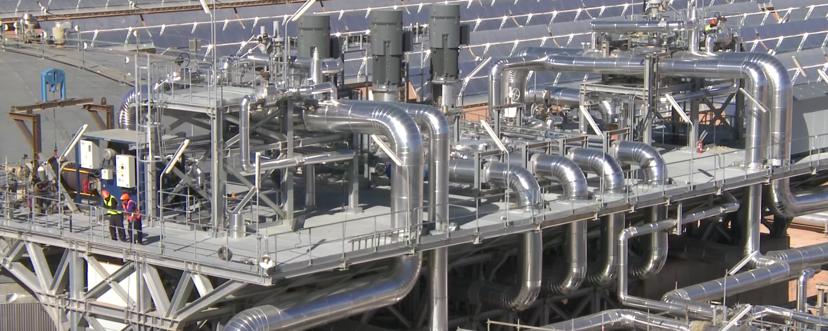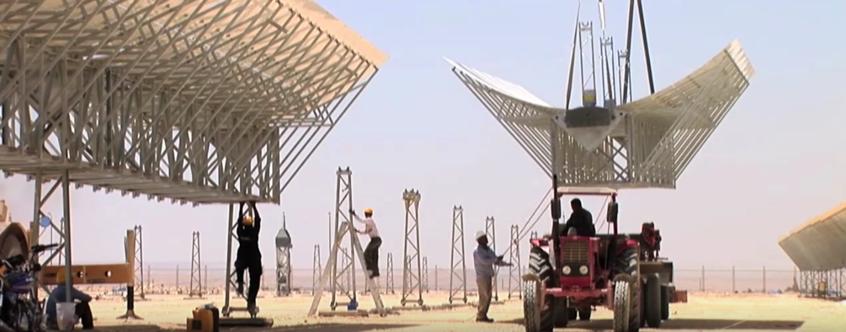Two weeks ago, when the King of Morocco ceremonially switched on the Noor I concentrated solar plant (CSP), he was hoping to turn his country into a renewable energy powerhouse over the next ten years.
But first the King has to stop the huge flow of energy imports that keep the country's lights on. If successful, then he wants to turn this nearly useless chunk of the Sahara Desert into a vital solar energy export hub.
Built by Saudi-owned ACWA Power, construction on the Noor I plant began in 2013 and cost about $1 billion. Its 500,000 mirrors cover thousands of acres and generate up to 160 megawatts, making this one of the world's biggest solar thermal power plants (press the release).
The largest solar plant in the world
Soon there will be several hundred thousand more mirrors covering the desert floor: that's because when the King commissioned Noor I, he also launched the construction of Noor II and Noor III (see this news report for more).
Eventually the large parabolic mirrors will cover an area as large as the city of Rabat, the country's capital. Paddy Padmanathan, CEO of ACWA Power, pointed out that currently, "You have 35 soccer fields of huge parabolic mirrors pointed to the sky." He added that the first phase should bring energy to about 500,000 people.
When the next two phases are finished, the 580 megawatt plant will be the single largest in the world. While supplying power to over 1,000,000 people, it will also reduce CO2 emissions by 760,000 tons a year and 17.5 million tons over 25 years.
The system's 39-foot-tall parabolic mirrors focus energy onto fluid-filled pipelines. The fluid's intense heat turns water into steam that powers a turbine. But this solar plant doesn't stop delivering energy at sundown. Any excess heat is stored in a tank of molten salts.
Storage for Noor l will generate electricity for three hours after nightfall, and the completed complex will produce power 20 hours a day.

Solar moguls
Morocco’s environment minister, Hakima el-Haite, believes that solar energy could have the same impact on the region this century that oil production had in the last. But the $9 billion project was triggered by energy insecurity, she told The Guardian.
“We're not an oil producer," el-Haite said. “So when we heard about the potential of solar energy, we thought: why not?”
Morocco’s goal is to make solar energy along with wind and hydro half of its energy supply by 2020. One day this could also power water desalination, in a country that is increasingly being punished by drought as the climate warms.
The government also plans to build power stations in other Moroccan cities, aiming to complete the Noor Project by 2018, which should produce 2,000 megawatts of solar energy.
Fueling innovation
CSP is such a promising technology that the International Energy Agency (IRENA) estimates that 11 percent of the world’s electricity generation in 2050 could come from CSP.
But high costs deter many utilities from using the technology, especially in emerging markets.
According to IRENA, CSP is one of the technologies with greatest potential for cost reductions.
To push the innovation cycle, the project has been funded by the World Bank, African Development Bank, European Investment Bank and private stakeholders. Its first phase cost an estimated $894 million, and the total price tag will be $9 billion, according to Moroccan officials.
The German government has also provided an $800 million loan for Noor II and III, which will have a combined capacity of 350 MW.
Those loans are actually a win-win proposition because Europe is desperately seeking new energy sources to leverage against Russia's on-again-off-again natural gas whims.
Regional aspirations
Morocco's ambitious agenda should pay off for the EU. “We're already involved in transmission lines to the south of Morocco and Mauritania,” said Ahmed Baroudi, manager of Morocco's national renewable energy investment firm. He said the project will eventually reach "as far as Mecca.”
Exporting solar should have stabilizing effects on the region, according to Masen, the Moroccan solar energy agency. Talks are already ongoing with Tunisia, while exports across the Mediterranean to the EU remain the ultimate goal.
There's already one interconnection between Europe and Morocco (through the Straits of Gibraltar), although today 5 billion kWh's a year are imported from Spain to help meet Morocco's current power shortfall. That should be reversed in time, and there are plans to build more transmission lines.
Padmanathan predicted: "If Morocco is able to generate electricity at seven, eight cents per kilowatt - very possible - it will have thousands of megawatts excess.
"This country should be able to export into Europe and it will. And it will not need to do anything at all…just sit there because Europe will start to need it."
Solar thermal technology will fall into “single figures,” he said, meaning below 10c/kWh, or $100/MWh), within a few years.

Long-term decision-making among utilities has obviously been disrupted. While there will be some coal projects coming on-line over the next few years - based on old, obsolete cost projections - in the future, most energy companies will completely reassess costs.
More renewables
To further ramp up energy production, Morocco just secured a low $US30/MWh bid for a 850MW wind farm.
The pricing, announced at the recent International Renewable Energy summit in Abu Dhabi, sets a record, which was helped by the site's predictably powerful Atlantic trade winds.
Abderrahim El Hafidi, vice minister of energy, described it as a “revolution,” comparing it to the latest bids for US projects that came in at $US25/MWh, although that included the 30 per cent federal production tax credit.
Steve Sawyer, the head of the Global Wind Energy Association, said that it "doesn’t mean that wind will be 3c/kWh ($30/MWh) everywhere. But there are a lot of places where it will be - Brazil, China, and parts of US.”
“Things have changed a lot,” El Hafidi told RenewEconomy. In 2009, wind and solar was much higher than fossil fuels, particularly coal, which was seen as relatively cheap.
“Now we have wind projects cheaper than coal," he said. The $30/MWh bid compares to coal which is 80/MWh.” So in the current price environment, even if the coal were free, a coal fired plant could not compete.
“We can have confidence in renewable energy for the future,” El Hafidi said. “This is real. It is not a claim.”


